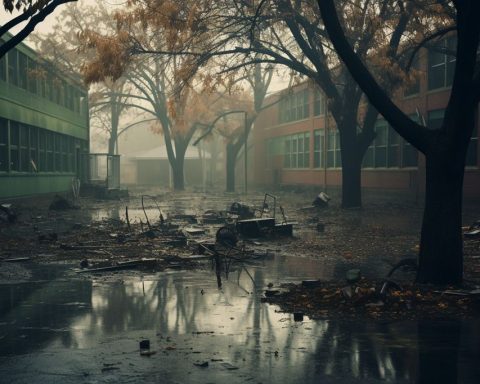South Africa is bracing for heavy rains and storms as a cut-off low-pressure system moves towards the Western and Eastern Cape regions. The system is expected to bring heavy rain, flooding, and thunderstorms, with the potential for rainfall amounts of 100mm or more within 24 hours. The South African Weather Services has issued Level 5 warnings for specific regions on Saturday and Sunday, and a Level 6 Orange Warning for parts of the Eastern Cape, urging the public to stay alert and prepared. The impending weather events highlight the importance of understanding and addressing environmental challenges on both local and global levels.
What is the cut-off low-pressure system and how will it impact South Africa?
According to the South African Weather Services, a cut-off low-pressure system is approaching the Western and Eastern Cape regions, which could result in heavy rains, flooding, and thunderstorms. The system is expected to reach the west coast on October 20th and could lead to rainfall amounts of 100mm or more within 24 hours, posing a significant risk to life and property. The Eastern Cape’s wet and soaked terrain increases the risk of flooding, and the SAWS has issued Level 5 warnings for specific regions on Saturday and Sunday, and a Level 6 Orange Warning for parts of the Eastern Cape.
South Africa is set to undergo a major change in weather patterns, with heavy rains and storms predicted across the Western and Eastern Cape regions over the weekend. A notorious cut-off low-pressure system is developing and swiftly advancing towards the Western Cape coastline. This article examines the intricacies of the meteorological events and the possible consequences of the forthcoming rainfall on South Africa’s landscape and communities.
The Cut-off Low-Pressure System:
The South African Weather Services (SAWS) has offered extensive information on the formation of a cut-off low-pressure system. These systems are distinguished by the low-pressure system’s equatorward movement at high altitudes. Generally, they produce substantial quantities of rain, often heavy, and are known for causing extreme weather events such as flooding, torrential rainfall, and thunderstorms.
Approaching Heavy Rain and Storms:
The swiftly evolving system is expected to reach the Western Cape’s west coast as early as October 20th’s evening. Numeric weather prediction (NWP) models indicate that some areas could experience rainfall amounts of 100 mm or more within 24 hours, potentially leading to flooding and posing a significant risk to life and property. The SAWS issued a Level 5 warning for specific regions on Saturday and Sunday, whereas a Level 6 Orange Warning has been released for parts of the Eastern Cape.
Impacts on Saturated Terrain:
The Eastern Cape’s surface terrain remains wet and soaked from recent rainfall episodes, resulting in diminished infiltration abilities. Additional rain on the already saturated ground will promptly lead to overland runoff, increasing the risk of flooding and causing river systems to expand. Both the environment and the impacted communities face significant threats.
Weather Evolution Over the Weekend:
As the cut-off low-pressure system continues to intensify, it is anticipated to move eastward rapidly throughout the weekend. By Sunday, the majority of the thunderstorms will have passed over the Western and Northern Cape, with attention shifting to the Eastern Cape and KwaZulu-Natal, where rainfall is expected to endure.
Community Involvement and Reporting:
The SAWS urges South Africans to stay alert and prepared for the upcoming weather conditions. They encourage the public to share photos and information about the storms, as long as they include necessary details. People can send their reports to the SAWS via WhatsApp, even anonymously if they wish.
Cultural and Historical Context:
Although South Africa has encountered numerous storms and heavy rainfall in the past, the intensity and frequency of such events have increased in recent years. This trend can be linked to broader climatic shifts and the impact of human activity on the environment. The impending weather events in the Western and Eastern Cape regions emphasize the significance of comprehending and addressing the challenges our rapidly changing climate presents on both local and global levels.
The Role of Art in Raising Weather Awareness:
Artists and cultural institutions have played a crucial part in raising awareness about weather events’ impacts and the importance of understanding and addressing environmental challenges. Various artistic movements, such as Land Art, have emerged as powerful tools to engage the public in environmental matters, illustrating the interconnections between human activity and nature. The approaching storms and heavy rains in South Africa present another opportunity for artistic expression to raise awareness and encourage a sense of responsibility and action towards our shared environment.
In conclusion, the heavy rains and storms anticipated over the Western and Eastern Cape regions of South Africa this weekend serve as a timely reminder of the intricate meteorological phenomena and challenges our rapidly changing climate presents. As the cut-off low-pressure system quickly approaches, the South African Weather Services has issued various warnings for specific areas, emphasizing the potential impacts on life, property, and the environment. It is essential for communities to remain vigilant and prepared, and for society as a whole to recognize and address the broader issues at play in our increasingly unpredictable world.
What are the potential impacts of the cut-off low-pressure system on South Africa?
The cut-off low-pressure system moving towards the Western and Eastern Cape regions could lead to heavy rains, flooding, and thunderstorms, with the potential for rainfall amounts of 100mm or more within 24 hours. This poses a significant risk to life and property, particularly in areas where the terrain is already soaked and susceptible to flooding.
What warnings have been issued by the South African Weather Services?
The South African Weather Services has issued Level 5 warnings for specific regions on Saturday and Sunday, and a Level 6 Orange Warning for parts of the Eastern Cape. The public is urged to stay alert and prepared for the potential impacts of the heavy rains and storms.
When is the cut-off low-pressure system expected to reach the Western Cape?
The cut-off low-pressure system is expected to reach the Western Cape’s west coast as early as the evening of October 20th.
What is the significance of the Eastern Cape’s saturated terrain?
The Eastern Cape’s surface terrain remains wet and soaked from recent rainfall episodes, resulting in diminished infiltration abilities. Additional rain on the already saturated ground will promptly lead to overland runoff, increasing the risk of flooding and causing river systems to expand.
How can the public report on the upcoming weather conditions?
The SAWS encourages the public to share photos and information about the storms, as long as they include necessary details. People can send their reports to the SAWS via WhatsApp, even anonymously if they wish.
What is the cultural and historical context of weather events in South Africa?
Although South Africa has encountered numerous storms and heavy rainfall in the past, the intensity and frequency of such events have increased in recent years. This trend can be linked to broader climatic shifts and the impact of human activity on the environment.
How can art play a role in raising awareness about weather events and environmental challenges?
Artists and cultural institutions have played a crucial part in raising awareness about weather events’ impacts and the importance of understanding and addressing environmental challenges. Through various artistic movements, such as Land Art, the public can engage in environmental matters, illustrating the interconnections between human activity and nature.
What is the broader significance of the impending weather events in South Africa?
The approaching storms and heavy rains in South Africa present an opportunity to raise awareness and encourage a sense of responsibility and action towards our shared environment. It emphasizes the significance of comprehending and addressing the challenges our rapidly changing climate presents on both local and global levels.











